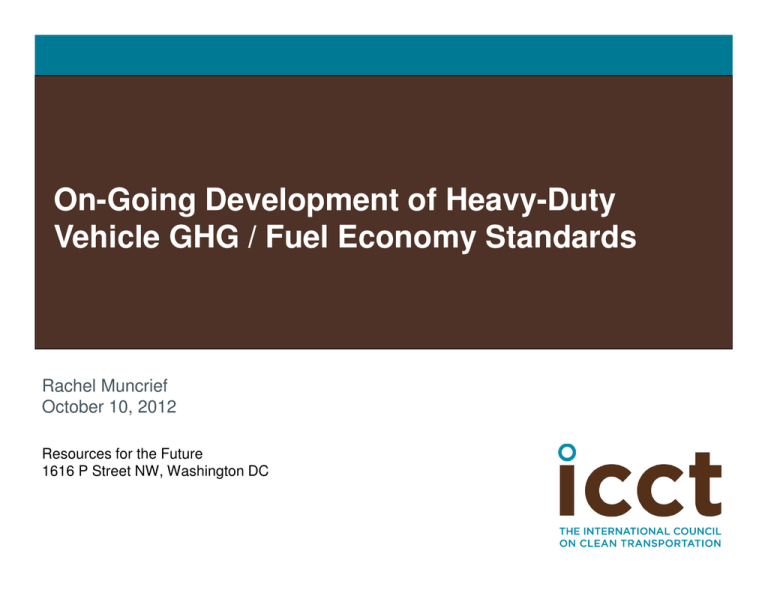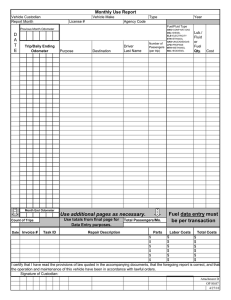On-Going Development of Heavy-Duty Vehicle GHG / Fuel Economy Standards Rachel Muncrief
advertisement

On-Going Development of Heavy-Duty Vehicle GHG / Fuel Economy Standards Rachel Muncrief October 10, 2012 Resources for the Future 1616 P Street NW, Washington DC Geographic Scope: Top Vehicle Markets Top eleven major global vehicle markets – Most have auto efficiency standards – Some working on truck standards Source: Ward’s Automotive Slide 2 Technology Potential in US Trucks National Academy of Sciences Report (March 2010) – Found 35 – 50% improvement achievable in 2015-2020 timeframe National Academy of Sciences (2010) FIGURE S-1 Comparison of 2015-2020 New Vehicle Potential Fuel Savings Technology for Seven Vehicle Types: Tractor Trailer (TT), Class 3-6 Box (Box), Class 3-6 Bucket (Bucket), Class 8 Refuse (Refuse), Transit Bus (Bus), Motor Coach (Coach), and Class 2b Pickups and Vans (2b). Also, for each vehicle class, the fuel consumption benefit of the Slide combined technology packages is calculated as follows: % FCpackage = 1 – (1 - %FCtech 1)(1 - %FCtech2)(1 - %FCtech N) where %FCtech x is the percent benefit of an individual technology. SOURCE: TIAX (2009) ES-4. 3 Compliance Example: Class 8 Tractor Technologies to go from baseline to compliance tractor – Example high-roof sleeper cab: 94 72 gCO2/ton-mile from 2010 to 2017 100 95 90 gCO2/ton-mile 85 80 75 70 MY2010baseline:94g/ton-mile 7 23%Reduc on 7 2 1 5 0.3 MY2017target:72g/ton-mile 7 65 60 Base Engine Aero(Bin Drive resSteer res Idle Weight Speed (MY2010) III) reduc on reduc onlimiter(60 mph) Based on US EPA / NHTSA 2014-2018 heavy duty vehicle regulatory assessment Slide 4 Technology Potential – Globally Different technologies have different value in different conditions – Approximate differences, compared to value in US context Technology US* Basis for Reduction Engine 20% Advanced 11-15L diesel with bottoming cycle Aerodynamics 11.5% Improved SmartWay tractor + three aerodynamic trailers Tires and Wheels 11% Improved WBS on tractor + three trailers Hybrid/Idle Reduction 10% Mild parallel hybrid with idle reduction Transmission 7% AMT, reduced driveline friction Management and Coaching/Spe ed limits 6% 60 mph speed limit; predictive cruise control with telematics; driver training Weight 1.25% Material substitution—2,500 lb. Japan China EU More Less Less Less More Less More Less Less Less Less More * These are based on NAS tractor-trailer Class 8 for US context; reductions are approximate, and are not additive Slide 5 Global HDV Potential – CO2 Reduction Early heavy-duty standards (Japan, US, China, etc) slow the emissions rise – Far greater potential exists to increase truck efficiency over the long-term 7.0 Heavy duty vehicle GHG emissions (Gt CO2e/year) Japan, Canada, EU Adopted US 2014-2018 HDV China Phase I HDV China Phase II HDV Mexico 2015-2018 HDV Vehicle Potential (3.5% APR) Global HDV Emissions 6.0 5.0 4.0 3.0 2.0 1.0 2000 2005 2010 Based on ICCT Roadmap project 2015 2020 2025 2030 Slide 6 Big Issues for 2020+ Regulation Test procedures: – Simulation vs testing? Separate engine standards? – Do we need full vehicle testing? How to incorporate all major technologies in regulations – – – – Transmission technologies Hybrid technology Incorporate tires, aerodynamics Inclusion of trailers Global alignment: – Merge different counties’ test procedures over time? Slide 7 Efficiencies Captured in Standard Efficiencies captured different in standards – Governments, industry interested in possible alignment Engine Japan U.S. China EU Yes Through separate engine standards Yes Yes Yes Yes - Yes Aerodynamic drag, but not rolling resistance Yes Transmission Somewhat Hybridization - Aerodynamic drag, rolling resistance No Optional; by demonstration outside of standard protocol By demonstration outside of standard protocol Yes Based on work by ACEEE Therese Langer Slide 8 Full vehicle testing? Full chassis dynamometer testing – – Allows ability test any vehicle configuration – Would allow for incorporation of advanced transmission, hybrids Disadvantages: – Capital and operating expense – Coastdown testing requirement Source: research.psu.edu * From recent ICCT SAE paper #2012-01-1986 9 Capturing Aerodynamics, Trailers Standard Trailer Testing of standard vs. optimized trailer * – Aerodynamic drag differs with speed • 40% of on-road resistance at 50 km/hr • 70% of on-road resistance at 88 km/hr – Optimized trailer benefits: • Constant speed: 4% aero improvement Optimized Trailer – 1% fuel consumption/CO2 decrease (highway) • Coastdown test: 9% aero improvement – ICCT work ongoing on trailers • How to best incorporate aerodynamic improvement? • Include trailers? Future? * Based on work by TU Graz Slide 10 Heavy Duty Regulation Alignment Motivation: – Facilitate compliance, reduce costs for global industry – Expedite emissions reductions by increasing the market size Elements – – – – – – Metrics Segmentation of vehicles Test cycles Test protocol Stringency Data and research Slide 11 Market Barriers – Research Many efficiency technologies are highly cost-effective – Have net societal benefit (energy savings > up-front cost) – Less than zero cost per ton CO2 reduced Why are these technologies not being deployed? Barriers include (*): – More focused on operational driver training – Low technology awareness by fleets – OEMs not offering technologies fully – High costs or high perceived costs of technology – Low and/or uncertain expected technology benefits (e.g., trailer technology) – Does not fit with operation Related ICCT Work – China industry survey (ongoing) – Workshop in Europe (Oct 2012) – US market barriers study (Jan 2013) * Based on CE-Delft “Market Barriers to Increased Efficiency in the European On-road Freight Sector” Slide 12 Summary HDV GHG / fuel economy standards are a critically important area of regulatory development for the US and globally. The search for continually improving upon regulatory design (metric, cycle, test method, etc) will continue for the next 5 to ten years at least. Important questions remain: – – – – Expand compliance options to full vehicle and trailer Simulation Modeling v. Chassis Dyno Hybrid technology development and incorporation Opportunities for global alignment of programs Slide 13 Extra Slides Slide 14 Cost Effectiveness of Technologies For Long Haul Segment Use* 55% 22% 92% 11% 9% 33% 83% 83% 10% 45% 0% *Results from 2012 EU Market Barriers Survey **Marginal abatement cost range using MACH model, 12 different scenarios Variables = Discount Rate, Vehicle Lifetime, Fuel Cost Slide 15 Test Procedure Summary key differences from US Feature U.S. China EU Road grade WTVC (China adjusted) Mission-based cycles (may include road grade, altitude, stops) Transient 90% Highway10% Road (rural) 10% Highways 90% No weighting necessary for mission-based cycles. 19 tons Similar Double Similar Simulation Engine fuel consumption map generated from engine dynamometer testing, enter into simulation Chassis test required for baseline. Simulation or chassis for improved model Simulation based on actual vehicle values Engine vs Full Vehicle Engine certification for fuel consumption separately No separate engine certification for fuel consumption No separate engine certification for fuel consumption No separate engine certification for fuel consumption Aerodynamic drag (Cd) Manufacturer testing to determine Cd (coastdown preferred) Standard value Manufacturer testing to determine Cd (coastdown preferred) or standard value Manufacturer testing to determine Cd (constant speed test preferred) Manufacturer testing to determine Crr for the steer and drive tire Standard value None Test Cycles Cycle Weighting Test Payload Test Method Rolling Resistance (Crr) CARB Transient Cycle and 55-mph and 65-mph cruise cycles. Transient 5%, 55-mph cruise 9% and 65-mph cruise 86% for sleeper cab tractor trucks. Japan Standard values from tire labels Slide 16 Test Procedures – Comparison Pro Con Comments Vehicle testing Represents “actual” vehicle performance over a given drive cycle; technology advances automatically captured in results; allows for compliance/enforcement testing. Expensive; test cycle(s) may not reflect full range of operation Can be chassis, track, or road testing Chassis Limited space requirements Does not capture aerodynamics or rolling resistance. Truck/Road Captures aerodynamics and rolling resistance Limited repeatability Vehicle simulation Less expensive; testing over multiple cycles as easy as testing over a single cycle; results are replicable Need extensive and continual updating to capture technology advances and ensure consistency with real-world performance Least expensive; most direct incentive to improve component efficiency Interactions of components not reflected; variations in performance over different cycles may not be accounted for Component-based Can be check list (SmartWay) or based on component performance (engine standards) Slide 17






